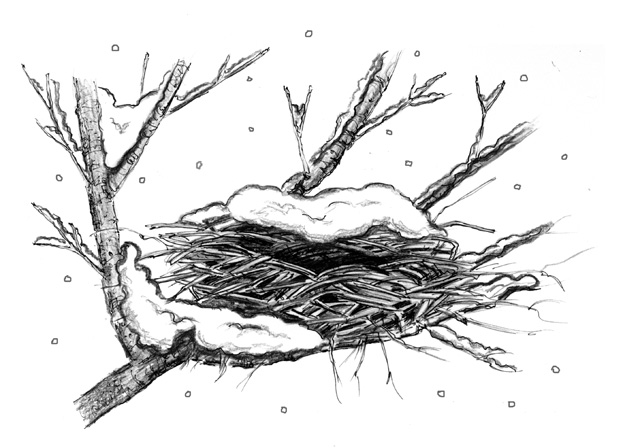
Dear Bird Folks,
Each winter I like to go out and collect dried plants and leaves, but this year I’m thinking about collecting old bird nests instead. Do you have any advice on locating them? Thanks.
–Jim, Stoughton, MA
Here’s my advice, Jim,
Don’t do it. Collecting nests might sound like a nice winter project, but it’s totally illegal. The law protects old rotting nests, even though no birds will ever use them again. Doesn’t make sense, right? Well, here’s the problem. Before people became sensitive to nature, they used to collect all of sorts bird parts. Beaks, talons and feathers were either used in fashion, or for odd religious purposes. People also collected bird eggs and nests. Some folks collected them for scientific reasons, but most did it because they simply liked to collected things (you know, hoarders). They didn’t care if the eggs were about to hatch or if the nests were in the middle of being used. If they found it, they kept it. To protect birds from these crazies the government passed the Migratory Bird Treaty Act of 1918. Now if you find a feather on the beach or a nest in the woods, you aren’t allowed to take it home and place it on your mantel. Will you be arrested if you are caught? I doubt it. The purpose of the law is to stop indiscriminant collecting, the kind that can be harmful to a species, not to put the casual nature lover in jail. But the law is the law and thus I can’t encourage you to break it (especially if there is nothing in it for me). However, I have a suggestion about how you can collect nests without getting yourself into trouble.
The best way to collect nests, and stay out of the slammer, is to simply take photos of any nests you find. Now before you blow off this idea, thinking that it’s totally lame, hear me out. In the year 2014, which I believe is the year we are in right now (it’s hard to keep up), it seems we all have a camera. If we don’t have one of those fancy cameras, we have a small point-and-shoot or a phone with a built-in camera. Any of these products would work just fine to help you capture images of nests you might find. In addition to keeping you out of jail, collecting photos will also prevent you from getting covered in nasty mites that nests sometimes contain. The other reason why photos are better than bringing home real nests; you won’t have listen to your wife scream, “Why did you drag those disgusting things into my nice clean house?” (That last one might only apply to me.)
The best time to look for old nests is in the late fall, when the leaves have just fallen off the trees and the once-hidden nests have become exposed. In the fall the nests are still fairly fresh and have not yet been torn apart by winter storms. Next, get yourself a notebook and a ruler. I hate to turn you into a total nerd, but the ruler will allow you to measure the width and depth of any nest you find, which will give you a rough idea of the size of the bird that built the nest. Also, jot down the material used in the nest construction, plus the type of tree or bush the nest was found in. Finally, note the nest’s height off the ground and distance from the tree trunk. I know all this note taking and measuring is a little clinical, but nest location is sometimes the most important clue. Folks regularly bring me nests that they’ve found. When I ask them where they found the nest, they’ll say something like, “In the driveway.” Without knowing the nest’s original location I can only make an educated guess as to which bird it belonged to. In other words, I have to make something up (but let’s keep that between us).
While late fall is the best time to find complete nests, the dead of winter also has its advantages, especially when the ponds freeze over. By walking on the ice you can search the bushes along the water’s edge and that is one of the best places to find old nests. Also, snow often gives nests a “snow cone” look, making them stand out among the tangles of branches and briars. One word of caution: many of the clumps we think are bird nests, are actually squirrel dens, or “dreys.” You can photograph these dreys all you want, but I wouldn’t put your hand, or anything else in them.
After you’ve hiked around all day, found a few nests, taken your photos and measurements, it’s time to head home, sit by the fire and dig out your nest books. There are several nest books available, but the most comprehensive is the Peterson Field Guide: Eastern Birds’ Nests, written by Hal Harrison. It has photos of over 280 nests, plus all of the statistical info I mentioned above. I really like this book. Over the years it has helped a lot of young naturalists, and made at least one bird store clerk look smart.
There’s one other way to enjoy old bird nests, Jim. Instead of doing all the measuring and note taking, just take some photos and be done with it. Forget who built it; use your camera to try and capture the beauty of the nest itself. I’ve seen some stunning photos of frosty nests, with a dramatic winter’s sky in the background. Finally, don’t fret if one of these nests somehow finds its way into your house. I don’t think the law will come looking for you because of just one old nest. However, if you mistakenly bring one of these nests into my house, after my wife has just cleaned it, the law will be the least of your worries.